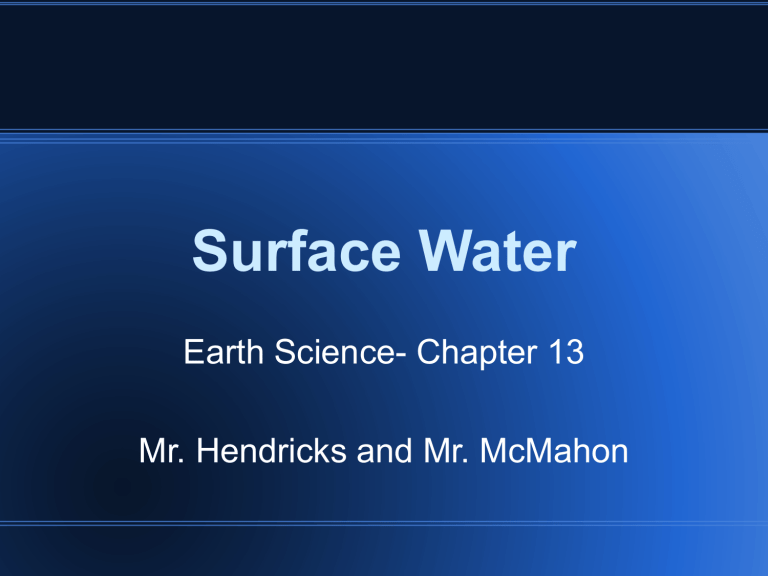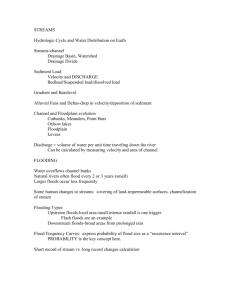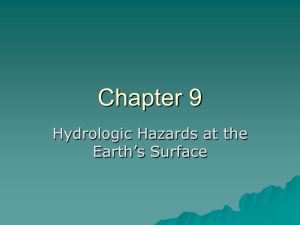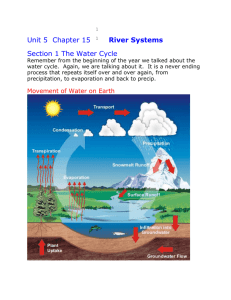Surface Water

Surface Water
Earth Science- Chapter 13
Mr. Hendricks and Mr. McMahon
Chapter Outline
Streams and River
Erosion and Deposition
River Valleys
Floodplains and Floods
Streams and Rivers
River Systems Vocabulary
- Continental Divide:
- Water Shed aka Drainage Basin:
- River system
- Tributary
River System
River System
• Definition- A river and all of its tributaries
(feeder river or connecting rivers)
• Example: Mississippi
River System
Drainage Basin or Watershed
Drainage Basin or
Watershedall is all the land that drains into the river directly or through it’s tributaries.
Example: green area is
Mississippi R. Basin
Continental Divide
• Defined as the highland that separates one drainage basin from another.
• Usually a mountain range
• Sub-Continental divide in Men. Falls
Tributary
• A tributary is a feeder river/ creek/ stream that flows into a large parent river.
• There are some 250 tributaries of the
Mississippi which drain a total area of more than 1,247,000 square miles--one third of the nation's landmass!
River Characteristics
Channelized flow- water flows in a chanel
Velocity- how fast a river is flowing
Gradient- how steep a river is
Discharge- how much water is flowing
Velocity
How fast something is moving
High velocity = high speed
Low velocity = low speed
Channelized Flow
Cross section of river displaying channelized flow
Rivers are “Confined” by their channel
Affects Velocity of water
Gradient
Slope of a stream
Rise over Run
A river may drop 10 feet over a distance of
100 feet
Gradient is 1/10 or 10%
Discharge
Cross Sectional Area = Width * Depth
5 ft * 100 ft = 500 ft 2
Velocity = 1 foot / second
Discharge = 500 ft 2 * 1 ft/sec
= 500 ft
3 / second
Discharge
Volume of water that passes a point over an amount of time
How much water is flowing in a river
Cross sectional area *
Velocity
Stream Discharge
How to determine discharge
Discharge = Cross sectional area * Velocity
Determine the discharge of a stream with the following characteristics:
Confined by two vertical walls.
The average depth of water is 5 feet.
The channel is 100 feet wide
Average velocity = 1 foot per second
Discharge
Discharge is not constant. Depends on conditions
Increased down river
Increased during times of high precipitation or melt
Spring = High
Discharge
Yearly Discharge
Erosion and Deposition
•
How does it happen?
Mechanical Weathering- Abrasion
Running water
• What does it produce?
Sediment
Rounded rocks
Potholes
Erosion, Transport, and Deposition
• Whether sediment is being eroded, transported, or deposited depends on the size of the particle and velocity of water
• Hjulstrom Curve
Color Hjulstrom
Transportation of Sediment
Load: material transported by river
Bedload: moved along bottom, rocks, gravel, pebbles
Suspension: clay- silt muddy water
Solution: material dissolved in water
Capacity:
total amount of sediment a stream can carry
Competence:
Maximize size particles a steram can carry
Stream Load
Stream Load
Deposition
Sediment is deposited when the velocity of the current can no longer transport material
Examples:
A boulder will not be transported by a trickling crick
A rapid river will move particles of all sizes because of the high V
Silt and Clay is deposited in the deep ocean because there is barely a current (low V)
Color Hjulstrom
Depositional Feautres
Delta
Sandbars
Deposit Bank
Delta
A fan-shaped deposit that forms when a river flows into a quiet or large body of water
Where do you think clay particles are deposited on the diagram?
Sand Bars
Wisconsin River-
How do they form?
-Discuss for 2 mins
Sand Bar Formation
Current carries sediment
Sediment is deposited when current is slowed down
Sediment begins to pile up and catch more sediment
Bars constantly move to change in current and water depth
River Deposit
Toad River, Canada
River Valleys
Why do some rivers grow so big?
All rivers start on a small scale
Rainstorm forms a valley in loose soils called a gullie
Rainstorm ends, water evaporates, but depression remains
Next rainstorm, erosion continues
As time goes on, a gullie increases length, width, and depth
Continuous erosion of land
Headward Erosion
The process by which land is worn away at the head of a stream or gully
Head: An abrupt drop in elevation
Waterfall
Erosion opposite the direction of waterflow
Canyons
• Canyon- river valley with steep vertical sides
• Form in areas with low rainfall
• Factors in formation:
Type of rock, amount of water, climate
• Colorado R. -Grand
Canyon)
V-Shaped Valleys
• Rain erodes the sides of a valley which forms a V shape
• Deeper channel = greater width
• Ex: Yellowstone River
Base Level
• Streams can’t cut any deeper than the body of water they flow into
• Ultimately, all rivers only can cut to sea level
Rapids and Waterfalls
• Water flowing over a cliff or steep, jagged slope forms rapids and waterfalls
• High rate of erosion at Rapids and WF
• Undermining
• Temporary features
Undermining
1) Waterfall creates pool
2) Undercuts the waterfall
3) Creates overhang
4) Overhang collapses
5) Recession upstream
Niagara Falls
Dry Niagrara Falls?
Floodsplains and Floods
• Features of a Floodplain:
• Meanders
• Oxbow Lake
• Natural Levees
Floodplain Features
Meander-River winding back and forth with broad curves
Features
• Oxbow Lake- A curved body of water that separates a meander from its river
• Formed due to erosion of river banks
Oxbow Lake
Floodplain Feature
• Natural Levee- thick deposits alongside stream banks
• Elevated ridges
Floods
• Naturally occurring event after heavy or long-lasting rains
• Positive and Negative
Effects
• Recent Flooding?
Flood Effects
Positive
• Relieve water and sediment overload of the channel
Negative
• Destructive for people near rivers
• Floods deposit minerals on floodplains making these areas fertile for agriculture
• Cause damage to buildings, farmland, and other properties
• Dangerous water levels/velocity
Flood Causes
• For large rivers, like the Mississippi, floods occur after many days of heavy, steady rainfall-
No flash floods
• Spring melt
• Dam failures- Ex: Lake Delton
Lake Delton
Flood Control and Prevention
• People rely on controlling and preventing floods
• Communities built on flood plains are of special concern
• Any time a flood occurs their property and their life is at risk
Flood Prevention/Control
Means:
1. Restore natural flood protections
– Replanting removed vegetation
– Urbanization = problem
2. Dams
– Creates reservoir
– Risk of failure – Lake Delton
– Eventually fill up with sediment
Flood Prevention Continued
3. Artificial Levees- sandbags
• Deeper river holds more water
• May create erosion downstream
4. Spillways
• Channels parallel to river to collect water
Floodgates
Artificial Levee
Youthful
Rapids
Waterfalls
Fast-moving water
Steep slope
Stream Stages
Old
Broad floodplain
Meanders
Oxbow lakes
Meander Scars
________ – the bends and curves of a stream
Oxbo w lake depositi on erosio n
____________ – deposit formed when a stream spreads out onto a less steep area
_____ – where a stream empties into a larger body of water
____________ – when an old age stream downcuts to “make it new again”






